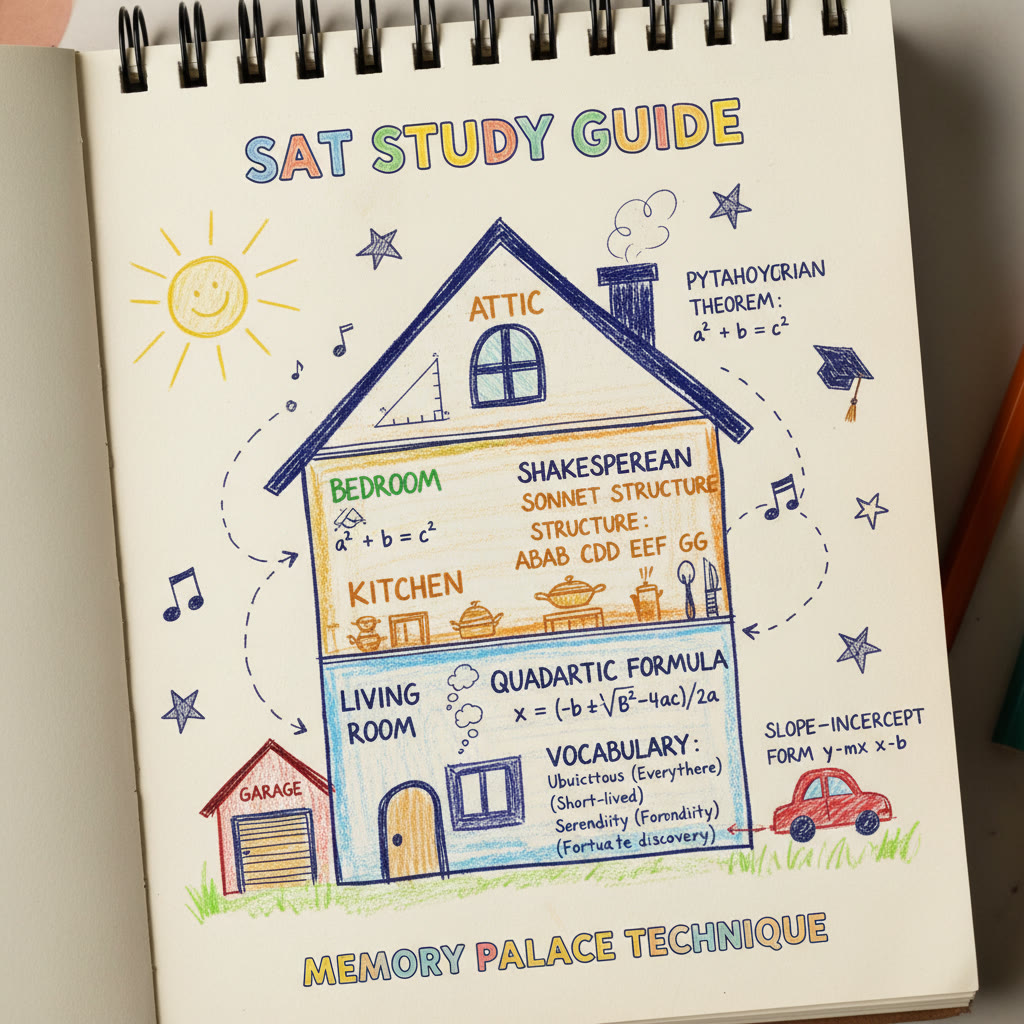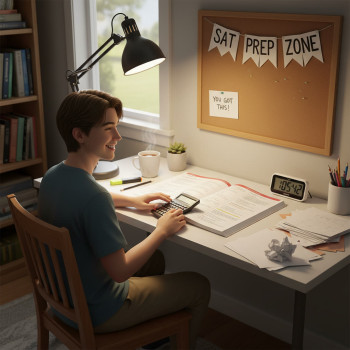Why Visualization Matters Before the SAT
Walk into a testing center confident, calm, and clear-headed — that’s the power of visualization. For students preparing for the SAT, visualization isn’t mystical thinking; it’s a practical mental rehearsal strategy that trains your brain to perform better under pressure. Athletes visualize a perfect swing. Musicians imagine nail‑perfect notes. You can use the same mental toolkit so that, on test day, your brain behaves more like a practiced pro than a nervous beginner.
What visualization actually is
At its core, visualization means creating vivid mental images and scenarios that simulate the experience you want to have. For the SAT, that could be picturing yourself calmly reading a dense passage and answering questions accurately, or mentally walking through a math problem until the solution feels obvious. Visualization engages multiple brain systems — attention, memory, and emotional control — making the imagined outcome easier to realize in real life.
The science-backed benefits (brief and useful)
Research in cognitive psychology and sports science shows that mental rehearsal can improve performance, reduce anxiety, and speed skill acquisition. When you visualize successfully solving problems and staying composed, you’re rehearsing neural pathways. That translates into:
- Reduced test anxiety and fewer panic moments.
- Faster retrieval of facts and strategies during the test.
- Improved focus and sustained attention for long sections.
- Better time management because you’ve practiced pacing internally.
Visualization Techniques That Work for the SAT
Not every mental image helps. Below are targeted techniques that fit specific SAT challenges — reading comprehension, time pressure, math reasoning, and the optional essay. Try them in sequence and note which feel strongest for you.
Mental rehearsal: run the whole test in your mind
Mental rehearsal is like a dress rehearsal for the real thing. Sit quietly for 10–15 minutes and run through a condensed version of test day. Imagine waking up, checking your test materials, sitting down in your seat, and starting the reading section with steady breathing. Visualize handling tricky passages and pacing yourself through math. The goal is predictability: the more familiar the scene, the less your mind will fear it on the actual day.
Scene-setting for calm: the pre-test micro-routine
Build a short 2–3 minute visualization you can use right before the exam starts:
- Close your eyes and take three deep, slow breaths.
- Picture the testing room from memory: the table, lighting, clock, and your admission ticket.
- See yourself placing your pencil down, scanning the first question, and smiling inwardly because you know how to handle it.
This micro-routine anchors you and provides a familiar cognitive cue that reduces adrenaline spikes.
Memory palace for tricky facts and rules
When formulas, grammar rules, or vocabulary must stick, the memory palace (method of loci) helps you place facts along an imagined route. For example, your front door could hold ‘parallel lines’ with a picture of two railroad tracks; your sofa could hold ‘subject-verb agreement’ pictured as a duo dancing in sync. When a grammar question pops up, mentally walk the route and retrieve the image — it’s faster and more reliable than rote lists.
Visual math mapping: sketching mentally before writing
For algebra and geometry, visualize the problem layout before touching paper. Picture the equation as a balance, variables as blocks you can move, and shapes as physical objects to rotate and inspect. If a problem describes a triangle, imagine holding it, turning it, and seeing right angles light up. This reduces wasted time fumbling to understand the prompt.
Passage visualization: turning words into movie clips
Dense reading passages become friendlier when you transform them into short movie clips. As you read, imagine the setting, the narrator’s voice, and actions as scenes. For persuasive passages, see the argument as a debate stage with props that represent claims and evidence. This helps you keep track of structure and tone for inference and main idea questions.
How to Practice Visualization Effectively (daily routines)
Visualization is a skill like any other: it improves with consistent, structured practice. Use these practical sessions during your study weeks to build reliability.
The 20-minute daily visualization session
A simple, repeatable session helps you solidify the habit. Try this format most days during the month before your test:
- 2 minutes: centering breaths to calm the nervous system.
- 5 minutes: quick memory palace walkthrough for 3–5 items (vocab or formulas).
- 8 minutes: mental rehearsal of a single SAT section (reading or math), slowing the pace to notice details.
- 5 minutes: visualization of the pre-test micro-routine and positive outcome affirmation.
Repeat the session after taking a practice test to consolidate that experience.
Weekly mixed-practice with real problems
Once or twice a week, combine visualization with actual practice questions. Read a passage or solve a problem, then close your eyes and visualize your approach before checking answers. This builds a feedback loop that ties mental rehearsal to correct strategies.
Sample 6-week plan: integrate visualization into SAT prep
The table below shows a sample calendar for integrating visualization with standard study time. Adjust minutes based on your schedule.
| Week | Daily Visual Practice | Weekly Focus | Goal |
|---|---|---|---|
| 1 | 15–20 minutes | Build micro-routine & basic memory palace | Reduce pre-test anxiety by familiarizing the scene |
| 2 | 20 minutes | Visual math mapping + one passage visualization | Improve comprehension speed and problem setup |
| 3 | 20–25 minutes | Connect visualization to timed practice | Maintain calm under time pressure |
| 4 | 25 minutes | Memory palace for formulas and targeted vocab | Faster recall during problem solving |
| 5 | 25–30 minutes | Full section mental rehearsals + review | Simulate test stamina and pacing |
| 6 | 15–20 minutes | Pre-test micro-routine & last-minute calming visualizations | Solidify calm and focus for test day |
Examples: Turn a technique into a real moment
Examples make abstract methods practical. Below are three real-style scenarios students commonly face and how visualization helps.
Reading passage: from dense text to short film
Example: a 700-word humanities passage on a historical figure’s motives. As you read the first paragraph, build an image of the setting — a dim study, a lit candle, a figure pacing. Assign a color or prop to each claim (a red book for the main claim, a blue quill for evidence). When you reach a question about tone, recall the scene’s lighting and the narrator’s posture. That visual detail often clarifies subtle cues you might miss when skimming.
Math problem: visual block manipulation
Example: a geometry question gives side lengths and asks for an angle measure. Rather than immediately writing equations, close your eyes briefly and rotate the shape in your mind. Imagine breaking the shape into familiar pieces — triangles you recognize. Picture the angle growing or shrinking as you move a side; that mental manipulation makes the algebraic relationships easier to set up on paper.
Essay planning: sketch a structure mentally
When preparing for the optional essay, visualize the paragraph structure as columns in a room. The introduction is the doorway, evidence sits on a table in the middle, and the conclusion is a window showing the view. Walk mentally from doorway to window, placing one specific example in each paragraph. This helps you write with clarity and organization under time constraints.
Comparison: Visualization vs. Rote Practice
Both methods have value. Rote practice builds familiarity through repetition; visualization strengthens the mind’s ability to call up that practice under stress. Here’s a quick comparison table to clarify when to use each.
| Feature | Rote Practice | Visualization |
|---|---|---|
| Best for | Memorizing formulas, vocabulary, typical problem types | Reducing anxiety, mental setup, exam-day simulation |
| Time cost | High (repetition over many sessions) | Moderate (short daily rehearsals) |
| When to use | Early prep and review | Before and during practice tests, test day |
Practical tips and troubleshooting
What if visualization feels silly or doesn’t work at first?
That’s totally normal. Your mind needs time to build sharp, useful images. Start small: close your eyes and picture a single object for 30 seconds. Add sensory details — color, texture, sound. The more details you weave in, the easier it becomes. Consistency wins here; after a week of short daily sessions, many students report clearer images and less resistance.
How to make visualizations crisp and reliable
- Use familiar locations for memory palaces to avoid confusion.
- Incorporate emotions and body sensations (calm breathing, relaxed shoulders) so images are linked to physical states.
- Practice both with eyes open (to bridge to actual test conditions) and closed (for deeper mental simulation).
- Pair visualization with quick written notes: after a mental rehearsal, jot 1–2 bullet points summarizing the approach. This strengthens the memory-consolidation loop.
How tutors can help—and how Sparkl’s personalized tutoring fits in naturally
Working with a tutor speeds up the learning curve for visualization techniques. Tutors provide immediate feedback on your mental strategies, suggest images that align with your thinking style, and show how to tie visualization to evidence-based strategies like active recall and spaced repetition.
If you’re using a personalized tutoring program such as Sparkl’s, you can expect one-on-one guidance to tailor visual routines to your strengths. Sparkl’s expert tutors help design tailored study plans, model visualization exercises during sessions, and use AI-driven insights to track what works best for you. The combination of human coaching and data-driven feedback makes visualization practice more efficient and targeted.
Test-day checklist: visualization edition
On your SAT day, run through this quick visualization checklist while waiting in the lobby or during the last few minutes before doors close:
- Two deep breaths; imagine the testing room and your seat.
- Pre-test micro-routine: scan, breathe, smile.
- Visualize solving the first question calmly and confidently.
- Picture a brief memory palace route for any last-minute vocab or formulas you want to anchor.
- Remind yourself: small mistakes won’t derail you; keep pacing and use the breaks.
Quick calming visualization for emergency panic
If you feel a sudden wave of anxiety in the test, use a 30-second exercise: breathe in for 4 seconds, out for 6. During the exhale, visualize a slow-motion scene of a single leaf falling and landing perfectly. Repeat for three breaths and return to the question with a clear, steady focus.


Measuring progress: how to know visualization is helping
Improvements from visualization might be subtle at first. Track these measurable signals to confirm it’s working:
- Lowered heart rate during practice tests or fewer panic episodes.
- Faster setup time on complex problems (you spend less time just understanding the prompt).
- Improved recall of formulas or details without looking at notes.
- Higher accuracy on sections where you used visualization compared with sections you didn’t.
Keep a short log after each practice test: note which visualization you used and any performance change. Over several weeks, patterns will emerge and inform your study plan.
Final tips and encouragement
Visualization is a skill that compounds. Fifty minutes of focused mental rehearsal is far more valuable than hours of distracted review. Make your practice deliberate: pair visualization with real practice questions, keep it short and consistent, and adapt images to your personal thinking style. If you struggle, reach out for targeted help — a skilled tutor can shorten the learning curve dramatically.
Some students get a surprising boost in confidence just knowing they have a mental toolkit to call on when the test gets hard. That calm confidence is often the difference between a good score and a great one.
And if you want tailored support, consider how Sparkl’s personalized tutoring can fit into your plan. Sparkl’s 1-on-1 guidance, tailored study plans, expert tutors, and AI-driven insights can help you design visualization routines that match your specific challenges and learning profile — so your practice time works smarter, not harder.
Closing—imagine your success
On test day, give yourself the gift of a practiced mind. Before you open the booklet, close your eyes for a moment and see the version of yourself who remains calm, reads clearly, and finishes strong. That image is not wishful thinking; it’s a rehearsed pattern your brain can follow. With consistent visualization practice, you give your best self a head start. Go steady, practice with purpose, and trust the process — you’ve got this.




















No Comments
Leave a comment Cancel